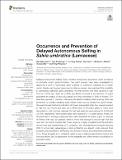Occurrence and prevention of delayed autonomous selfing in Salvia umbratica (Lamiaceae)
Abstract
Delayed autonomous selfing (DAS) provides reproductive assurance under conditions of pollinator and/or pollen-limitation. Few plant species have been investigated to determine if DAS is terminated when a flower is sufficiently pollinated by a pollen vector, thereby saving plant resources for other purposes. We examined this possibility in bumblebee-pollinated Salvia umbratica. We first showed that DAS resulting in high fruit set (100%) and seed set (>80%) per flower occurred in the absence of insect pollinators by means of style recurvature and was completed in 94% of flowers 72 h after they opened. In contrast, in flowers pollinated immediately after opening, DAS was prevented by corollas dropping away before styles recurve toward the upper thecae. We next showed that hand-pollination of flowers immediately after they opened resulted in high fruit set (100%) and seed set (>80%) when 5–10 pollen grains or more were deposited on their stigmas, whereas fruit set and seed set were reduced to 45.00 and 22.50%, respectively, when pollen loads were reduced to 1–3 pollen grains. Finally, we showed that on average single pollinator visits deposited 26 pollen grains on stigmas of flowers that had just opened, which is more than enough to ensure high fruit and seed set. Our results indicate that flower longevity is highly correlated with the pollinator environment and female fitness of S. umbratica, with extended flower longevity allowing DAS to occur being advantageous when pollinators are absent, while reduced floral longevity and prevention of DAS being favored when flowers are pollinated by pollinators. Thus, flower longevity in S. umbratica varies so as to optimize reproductive output and resource efforts, and is dependent on the availability and effectiveness of pollinators to pollinate flowers.
Citation
Xiao , H-W , Huang , Y-B , Chang , Y-H , Chen , Y , Abbott , R J , Wei , Y-K & Ma , Y-P 2021 , ' Occurrence and prevention of delayed autonomous selfing in Salvia umbratica (Lamiaceae) ' , Frontiers in Plant Science , vol. 12 , 635310 . https://doi.org/10.3389/fpls.2021.635310
Publication
Frontiers in Plant Science
Status
Peer reviewed
ISSN
1664-462XType
Journal article
Description
This work was supported by Specific Project for Strategic Biological Resources and Technology Supporting System from the Chinese Academy of Sciences (No. ZSZY-001), Chenshan Special Foundations from Shanghai Municipal Administration of Forestation and City Appearances (Nos. G162408, G172410, and G182409), the Science and Technology Program of Shanghai Science and Technology Committee (No. 20392000600), the Reserve Talents for Academic and Technical Leaders of Middle-aged and Young People in Yunnan Province (Grant No. 2018HB066), and Ten Thousand Talent Program of Yunnan Province (Grant No. YNWR-QNBJ-2018-174).Collections
Items in the St Andrews Research Repository are protected by copyright, with all rights reserved, unless otherwise indicated.

